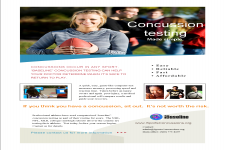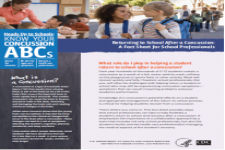Return-to-play
- Created on Friday, 07 January 2011 07:01
- Last Updated on 18.09.2012
- Published Date
Adults heal faster than youth
Knowing when an athlete's brain has completely healed from a concussion is difficult. A trained medical professional should make the return-to-play (RTP) decision for each athlete individually. They will want to make sure all physical and cognitive symptoms have resolved at rest and during exertion. A balance assessment and cognitive evaluation may also be included in the assessment.
If the athlete has taken a cognitive "baseline" concussion test at the beginning of their sports season (offered by many school districts and sports organizations) a second test will be administered and the results of the two tests will be compared. When the post-injury results match the pre-injury "baseline" results, and all physical and cognitive symptoms have disappeared at rest and during exertion, the medical professional may be comfortable allowing the athlete to return to activity. Other factors the medical professional may consider include the number of previous concussions, the severity of symptoms, and the type of sport the athlete is engaged in.
Give it time
Most concussions heal within a few days to three weeks. It is impossible to predict however, how long any one individual's recovery process will take. The fastest road to recovery is to limit cognitive activity such as reading, TV, texting, or computer usage, as well as physical activity. It is important not to re-injure an already injured brain or to place any undo stress upon it while it heals. Learn more...
It's a gradual process
After all physical and cognitive symptoms have disappeared, it's very important to increase physical exertion gradually. Successfully completing the gradual return-to-play protocol developed by a panel of international experts will help guide an athlete's recovery. If symptoms return during this process, then more healing time is required. Learn more...
Questions/comments? Contact Jean Rickerson at This email address is being protected from spambots. You need JavaScript enabled to view it.
Brain Health
Children and young adults scanned multiple times by computed tomography (CT), a commonly used diagnostic tool, have a small increased risk of leukemia and brain tumors in the decade following their ...
read more...-
Why concussions affect people differently
Bronx, NY — Patients vary widely in their response to concussion, but scientists haven’t unde...
-
Teens miss recovery clues after concussion
PITTSBURGH — When recovering from concussion, young athletes rely too much on how they f...
-
Discovering the roots of migraine
Common questions encountered during the post-concussion exam are often migraine-related. Do you...




Neuroscience
NFL Hall of Famer "Iron Mike" Webster's life ended in 2002 when he suffered a heart attack at age 50. Four Super Bowl rings, nine Pro Bowls, and voted to the NFL's all-time team in 2000, the driven, ...
read more...-
Progesterone seems to protect neurons after injury
It is not yet known why girls suffer concussions at a higher rate than boys. The most prevalent...
-
911 signal relay sends help to brain injury
Like emergency workers rushing to a disaster scene, cells called microglia spe...
-
GPS for the brain; the "connectome"
Athens, Ga.- University of Georgia researchers have developed a map of the human brain that shows...
Resources
- School professionals play an important role in the health of all students. Recognizing the signs and symptoms of concussion is important, as is managing their return to school post-injury.
- Some ...
- https://
- CDC's Concussion Training for Clinicians
-
Concussion Education Video Programs - ...
Parents, athletes, coaches and medical professionals have access to concussion education created...
-
New concussion guidelines for team ...
INDIANAPOLIS – Team physicians who assess and treat athletes suspected of concussion have new ...
The risk of concussions in young football players
Marjorie Albohm President, National Athletic Trainers' Association
quick links
Latest News
Concussions Occur...
...in Any Sport
REMOVE athlete from play
REFER to medical provider
REST no sports, no texting/TV
RETURN only with doctor's OK
Source: Children's Hospital Boston, Sports Concussion Clinic
































